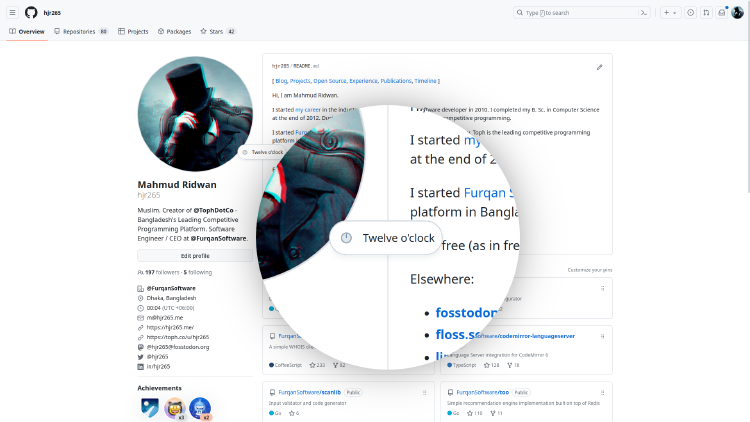My GitHub Status Is A Clock
On GitHub, you can set an emoji and a short message as your status. I don’t browse GitHub much. But through what little I do, I see so many profiles with “:dart: Focusing”.
Why not make it a clock? An almost functional clock.
That’s exactly what I did.: github.com/hjr265

I wrote a Go program that I can leave running. The program updates my GitHub status with one of the clock emojis (one that is close to the current time) and a message saying something like “Twelve o’clock” or “Half past twelve”.
This blog post is about how it works. You can find the source code for this on GitHub.
Time to Emoji

Given a Go time.Time we need to be able to choose one of the 24 clock emojis. The emojis are named “:clock12:”, “:clock1230:”, “:clock1:”, “:clock130:”, and so on.
The name follows the pattern “:clock{h}:” or “:clock{h}30:”, where “{h}” is the hour.
| |
For the hour part, we first go from 24-hour to 12-hour. Since we may end up with h == 0, we just change that to 12.
For the minute part, we round down to the nearest 30.
If then the minute part is 0, we return “:clock{h}:”. Otherwise, we return “:clock{h}{m}:”.
Time to Message

Depending on the current time, we set one of the two messages: “{Hour} o’clock” or “Half past {hour}”.
| |
Here we follow the math similar to timeToEmoji. Except, we return “{Hour} o’clock” when rounded down minutes is 0. Otherwise, we return “Half past {hour}”.
We keep a map of twelve numbers (1 to 12) in words. We use words for hours here instead of numbers.
Putting It Together

The program goes something like this:
- Set up a GitHub GraphQL client. We use
github.com/shurcooL/githubv4for this. - Loop:
- Update status based on current time.
- Sleep until another update is needed.
| |
The sleepDuration function looks at the time.Time passed to it and calculates the number of minutes left until the next 30-minute or 60-minute mark (whichever is the closest).
Get A Clock

You can find the source code for this on GitHub.
You can also install this program with the go install command and run it like so:
| |
This post is 39th of my #100DaysToOffload challenge. Want to get involved? Find out more at 100daystooffload.com.
comments powered by Disqus